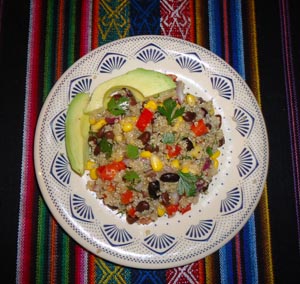Mexican Kitchen

In researching the origins of various foods, it is fascinating to contemplate how different so many of the world’s cuisines would be without the culinary exchanges that took place during the 15th to17th centuries — the Age of Exploration.
New World food — generally referring to ingredients that existed in the Americas before the Europeans arrived, such as corn, beans, squash, tomatoes and potatoes, to name a few — had a tremendous impact on European menus. And the fruit, nuts, spices, meat and dairy foods brought from the Old World changed the diets of the Americas forever.
Why, then, did it take so long for the rest of the world to discover quinoa, the centuries-old sustenance crop of the Andes? Held sacred by the Incas, who called it “the mother of all grains,” quinoa is actually a pseudo grain, consisting of seeds, and is not a member of the grass family, so it does not contain gluten. It is a welcome addition to meals in Mexico, where it has gained enormous popularity and taken on characteristic Mexican flavors.
The Spanish conquerors looked down on quinoa as food for the indigenous people, and forbade its cultivation in the Andean region, just as they did with amaranth in Mexico, and for the same reason: because it was used in pre-Hispanic religious ceremonies. Instead, inhabitants of both places were forced to grow wheat, the grain of the Christian communion wafer and much of Europe’s bread.
While the old ban on quinoa production may have prevented its dispersion outside the Andean region, the current emphasis on gluten-free diets has led to an enormous increase in its worldwide consumption. The United Nations has declared the upcoming 2013 to be the International Year of Quinoa, and its stellar nutritional profile merits this recognition.
Quinoa, its name derived from the Quechua word kinwa, is a member of the chenopodium family, as are amaranth and epazote, and contains significant amounts of calcium, phosphorous and iron, in addition to all eight essential amino acids, which make it a complete protein. It is also a good source of dietary fiber and, being gluten free, is easy to digest.
Once found only in a few health food stores in Mexico City, quinoa is now sold throughout the country, including in Guadalajara, Monterrey, Puebla, Querétaro, Cancun, Cuernavaca, Veracruz, Puerto Vallarta, Toluca and Hermosillo, as well as several neighborhoods in the Distrito Federal. Its method of preparation is similar to that of rice, making it easily adaptable to Mexican rice recipes.
Quinoa is coated with a substance called saponin, a natural insect repellant, making the use of pesticides unnecessary. It is sold both packaged and in bulk, and most of the packaged quinoa is labeled as being pre-rinsed, meaning that the saponin has been washed off. This substance is not harmful, but can be bitter, so when buying in bulk or harvesting from a home garden, always rinse quinoa thoroughly, just as you would Mexican rice. (Rice is milled differently in Mexico than it is north of the border, and needs to be rinsed of excess starch.)
Quinoa is good in soups, salads, side dishes and even as a vegetarian main course. The proportion of cooking liquid to quinoa is two-to-one, like rice, and like rice, it can be sautéed with aromatics before adding liquid, pilaf style. (This is the technique brought to Spain by the Moors, and the basis for Mexican red rice.)
Quinoa makes a great base for filling in chiles rellenos, either with or without meat. It also makes a good hot breakfast cereal, on its own or combined with eggs. Try it with vegetables in scrambled eggs, or top a quinoa and bean mixture with salsa and a fried egg for a brunch reminiscent of huevos rancheros.
For a list of stores throughout Mexico that sell quinoa, go to https://www.quinoamexico.es.tl/-Donde-Encuentro-Quinoa-en-Mexico.htm and try the following recipes, combining Mexican flavor and great nutrition.
- Mexican quinoa vegetable soup: Sopa de quinoa y verduras
- Mexican quinoa and eggs ranchero: Quinoa con huevo, estilo ranchero
- Stuffed poblano chiles with quinoa: Chiles rellenos con quinoa
- Mexican black bean and quinoa salad: Ensalada de quinoa con frijoles negros


